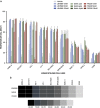Overcoming inherent resistance to histone deacetylase inhibitors in multiple myeloma cells by targeting pathways integral to the actin cytoskeleton
- PMID: 24651437
- PMCID: PMC3973216
- DOI: 10.1038/cddis.2014.98
Overcoming inherent resistance to histone deacetylase inhibitors in multiple myeloma cells by targeting pathways integral to the actin cytoskeleton
Abstract
Histone deacetylase inhibitors (HDACi) are novel chemotherapeutics undergoing evaluation in clinical trials for the potential treatment of patients with multiple myeloma (MM). Although HDACi have demonstrable synergy when combined with proteasome inhibitors (PIs), recent evidence indicates that combination of HDACi and PI is beneficial only in a subset of patients with advanced MM, clearly indicating that other rational combinations should be explored. In this context we hypothesized that understanding the molecular signature associated with inherent resistance to HDACi would provide a basis for the identification of therapeutic combinations with improved clinical efficacy. Using human myeloma cell lines (HMCL) categorized as sensitive, intermediate or resistant to HDACi, gene expression profiling (GEP) and gene ontology enrichment analyses were performed to determine if a genetic signature associated with inherent resistance to HDACi-resistance could be identified. Correlation of GEP to increasing or decreasing sensitivity to HDACi indicated a unique 35-gene signature that was significantly enriched for two pathways - regulation of actin cytoskeleton and protein processing in endoplasmic reticulum. When HMCL and primary MM samples were treated with a combination of HDACi and agents targeting the signaling pathways integral to the actin cytoskeleton, synergistic cell death was observed in all instances, thus providing a rationale for combining these agents with HDACi for the treatment of MM to overcome resistance. This report validates a molecular approach for the identification of HDACi partner drugs and provides an experimental framework for the identification of novel therapeutic combinations for anti-MM treatment.
Figures






Similar articles
-
DNA microarray profiling of genes differentially regulated by the histone deacetylase inhibitors vorinostat and LBH589 in colon cancer cell lines.BMC Med Genomics. 2009 Nov 30;2:67. doi: 10.1186/1755-8794-2-67. BMC Med Genomics. 2009. PMID: 19948057 Free PMC article.
-
DNMTi/HDACi combined epigenetic targeted treatment induces reprogramming of myeloma cells in the direction of normal plasma cells.Br J Cancer. 2018 Apr;118(8):1062-1073. doi: 10.1038/s41416-018-0025-x. Epub 2018 Mar 2. Br J Cancer. 2018. PMID: 29500406 Free PMC article.
-
Over-expression of clusterin is a resistance factor to the anti-cancer effect of histone deacetylase inhibitors.Eur J Cancer. 2009 Jul;45(10):1846-54. doi: 10.1016/j.ejca.2009.03.002. Epub 2009 Apr 1. Eur J Cancer. 2009. PMID: 19342222
-
[Drug-Resistant Mechanism of Multiple Myeloma and Its Therapy Combined with HDACi -Review].Zhongguo Shi Yan Xue Ye Xue Za Zhi. 2017 Apr;25(2):608-612. doi: 10.7534/j.issn.1009-2137.2017.02.055. Zhongguo Shi Yan Xue Ye Xue Za Zhi. 2017. PMID: 28446321 Review. Chinese.
-
New insights into the treatment of multiple myeloma with histone deacetylase inhibitors.Curr Pharm Des. 2013;19(4):734-44. Curr Pharm Des. 2013. PMID: 23016853 Free PMC article. Review.
Cited by
-
Autophagy and Apoptosis: Current Challenges of Treatment and Drug Resistance in Multiple Myeloma.Int J Mol Sci. 2022 Dec 30;24(1):644. doi: 10.3390/ijms24010644. Int J Mol Sci. 2022. PMID: 36614089 Free PMC article. Review.
-
RGS12 inhibits the progression and metastasis of multiple myeloma by driving M1 macrophage polarization and activation in the bone marrow microenvironment.Cancer Commun (Lond). 2022 Jan;42(1):60-64. doi: 10.1002/cac2.12228. Epub 2021 Dec 20. Cancer Commun (Lond). 2022. PMID: 34931491 Free PMC article. No abstract available.
-
HDAC5-LSD1 axis regulates antineoplastic effect of natural HDAC inhibitor sulforaphane in human breast cancer cells.Int J Cancer. 2018 Sep 15;143(6):1388-1401. doi: 10.1002/ijc.31419. Epub 2018 Apr 20. Int J Cancer. 2018. PMID: 29633255 Free PMC article.
-
Histone deacetylase inhibitors in multiple myeloma: from bench to bedside.Int J Hematol. 2016 Sep;104(3):300-9. doi: 10.1007/s12185-016-2008-0. Epub 2016 Apr 20. Int J Hematol. 2016. PMID: 27099225 Review.
-
Role of epigenetics-microRNA axis in drug resistance of multiple myeloma.J Hematol Oncol. 2017 Jun 17;10(1):121. doi: 10.1186/s13045-017-0492-1. J Hematol Oncol. 2017. PMID: 28623912 Free PMC article. Review.
References
-
- Greipp PR, San Miguel J, Durie BG, Crowley JJ, Barlogie B, Blade J, et al. International staging system for multiple myeloma. J Clin Oncol. 2005;23:3412–3420. - PubMed
-
- Siegel DS, Dimopoulos MA, Yoon SS, Laubach JP, Kaufman JL, Goldschmidt H, et al. Vantage 095: vorinostat in combination with bortezomib in salvage multiple myeloma patients: final study results of a global phase 2b trial. Blood. 2011;118:223–224. - PubMed
Publication types
MeSH terms
Substances
LinkOut - more resources
Full Text Sources
Other Literature Sources
Medical
Research Materials
Miscellaneous

